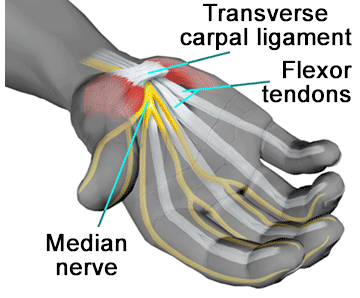

The muscle symptoms are not as easily recognized due to their subtlety when compared to the numbness. In addition to numbness and tingling of the fingers, there can be associated muscle symptoms as well since the affected nerve provides input to muscles of the thumb. In severe cases of carpal tunnel syndrome, patients may also have consistent numbness in the affected fingers throughout the day that does not cease. Many patients will describe needing to shake their hand or allow their hand to hang over the edge of the bed in order to get relief. Moreover, once patients wake from sleep due to the symptoms, they may have significant difficulty going back to sleep as a result of the severe numbness. This can be extremely disconcerting to have such disrupted sleep. However, it can become so severe that patients will wake multiple times throughout the night every night of the week. Initially patients may have symptoms that wake them from sleep one or two times per week. As the condition progresses, the main reason that will drive patients to seek care is numbness and tingling in the affected fingers that mostly occurs at nighttime. Symptoms can be mild and last for several seconds to minutes. In the early stages of the condition, patients will describe numbness and tingling in the affected fingers that is not consistent. The age of onset of symptoms is highly variable and I have treated patients in their early 20s to their late 90s with this condition.

The pinky finger is not involved because it has a different nerve providing sensation input. Why then do some people develop carpal tunnel syndrome and why do some not? This question remains unanswered.Ĭarpal tunnel syndrome manifests with numbness and tingling in the thumb, index finger, middle finger, and half of the ring finger.

As humans, our anatomy is similar regardless of gender, race, or age. However, this has been disproven and job-related tasks do not seem to correlate with the development of carpal tunnel syndrome. Classical belief was that typing on the computer all day resulted in the development of carpal tunnel syndrome. The cause of carpal tunnel syndrome is poorly understood. Under normal circumstances this relationship allows the extraordinary function and sensation of the hand to work properly.

The median nerve provides input to the muscles that control motion in the thumb. The sensation is provided to the thumb, index finger, middle finger, and half of the ring finger. The median nerve supplies both sensation and muscle function to the hand. The median nerve, as do all nerves, functions as an electrical cable sending electrical signals back and forth between the brain and body part that it supplies. The nerve sits inside of a tight canal called the carpal tunnel on the palm side of the hand. It is the most common diagnosis that I see in the office as a hand surgeon. Carpal tunnel syndrome refers to compression of the median nerve at the junction of the hand and the wrist (i.e.


 0 kommentar(er)
0 kommentar(er)
